Page 522 of 602

Vehicle care and maintenance7-21
7
Battery
N00939100930
The condition of the battery is very important for quick starting
and to keep the vehicle’s electrical system working properly.
Check the battery regularly.
If battery performance is suspect, have the battery and charging
system tested by an authorized Mitsubishi Motors dealer or a
repair facility of your choice.NOTE�
After replacing the battery, the electronic control system
data for the automatic transaxle, etc., will be erased.
As a result, shifting may be rough.
Shifting will become smoother after several changes in
speed.During cold weather
N00901600031
The battery is weaker in cold temperatures. This has to do with
its chemical and physical properties and is why a very cold bat-
tery, especially one with a low charge, will have a hard time
starting your vehicle.
It is recommended that you have your battery and charging sys-
tem checked by an authorized Mitsubishi Motors dealer or a
repair facility of your choice before the start of cold weather. If
necessary, have it charged. This will guarantee more reliable
starting, and longer battery life.
Disconnection and connection
N00901700074
To disconnect the battery cable, stop the engine. Disconnect the
negative (-) terminal first, then the positive (+) terminal. To
reconnect the battery, first connect the positive (+) terminal and
then the negative (-) terminal, before starting the vehicle.NOTE�Open the terminal cover (A) before disconnecting or con-
necting the positive (+) terminal of the battery.
� Loosen the nut (B) and then disconnect the battery cable
from the positive (+) terminal.
BK0150700US.book 21 ページ 2012年3月22日 木曜日 午後6時46分
Page 528 of 602
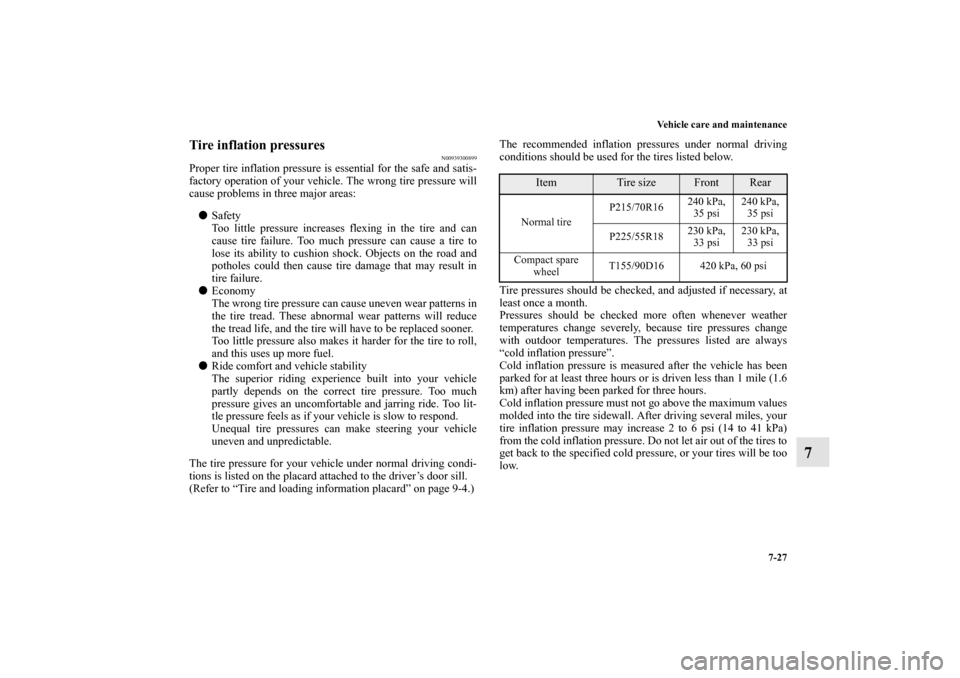
Vehicle care and maintenance7-27
7
Tire inflation pressures
N00939300899
Proper tire inflation pressure is essential for the safe and satis-
factory operation of your vehicle. The wrong tire pressure will
cause problems in three major areas:� Safety
Too little pressure increases flexing in the tire and can
cause tire failure. Too much pressure can cause a tire to
lose its ability to cushion shock. Objects on the road and
potholes could then cause tire damage that may result in
tire failure.
� Economy
The wrong tire pressure can cause uneven wear patterns in
the tire tread. These abnormal wear patterns will reduce
the tread life, and the tire will have to be replaced sooner.
Too little pressure also makes it harder for the tire to roll,
and this uses up more fuel.
� Ride comfort and vehicle stability
The superior riding experience built into your vehicle
partly depends on the correct tire pressure. Too much
pressure gives an uncomfortable and jarring ride. Too lit-
tle pressure feels as if your vehicle is slow to respond.
Unequal tire pressures can make steering your vehicle
uneven and unpredictable.
The tire pressure for your vehicle under normal driving condi-
tions is listed on the placard attached to the driver’s door sill.
(Refer to “Tire and loading information placard” on page 9-4.) The recommended inflation pressures under normal driving
conditions should be used for the tires listed below.
Tire pressures should be checked, and adjusted if necessary, at
least once a month.
Pressures should be checked more often whenever weather
temperatures change severely, because tire pressures change
with outdoor temperatures. The pressures listed are always
“cold inflation pressure”.
Cold inflation pressure is measured after the vehicle has been
parked for at least three hours or is driven less than 1 mile (1.6
km) after having been parked for three hours.
Cold inflation pressure must not go above the maximum values
molded into the tire sidewall. After driving several miles, your
tire inflation pressure may increase 2 to 6 psi (14 to 41 kPa)
from the cold inflation pressure. Do not let air out of the tires to
get back to the specified cold pressure, or your tires will be too
low.
Item
Tire size
Front
Rear
Normal tire
P215/70R16
240 kPa,
35 psi 240 kPa,
35 psi
P225/55R18 230 kPa,
33 psi 230 kPa,
33 psi
Compact spare wheel T155/90D16 420 kPa, 60 psi
BK0150700US.book 27 ページ
2012年3月22日 木曜日 午後6時46分
Page 531 of 602
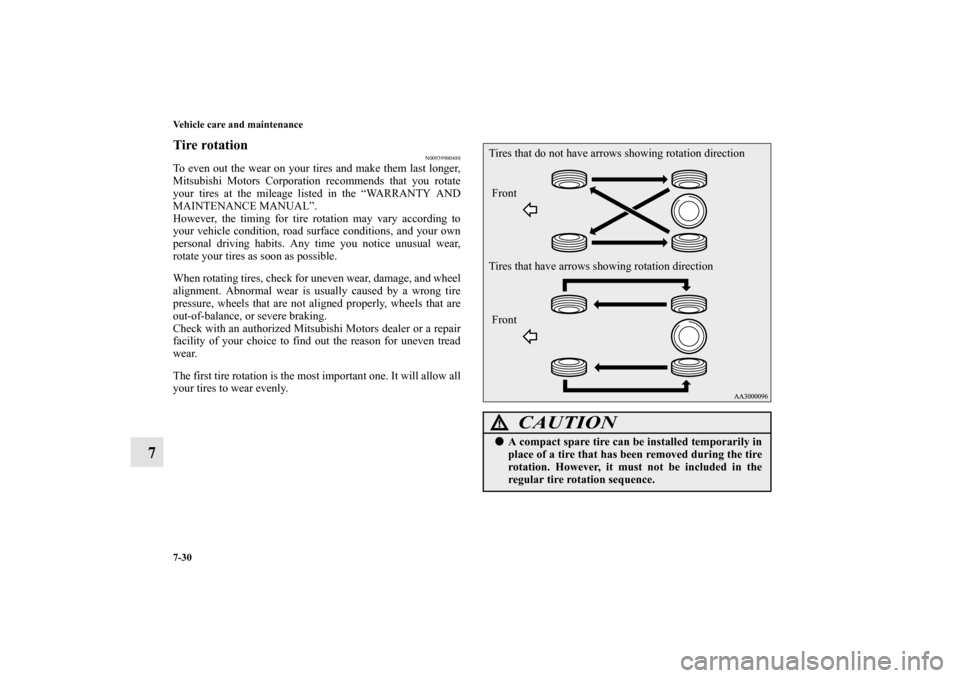
7-30 Vehicle care and maintenance
7
Tire rotation
N00939900488
To even out the wear on your tires and make them last longer,
Mitsubishi Motors Corporation recommends that you rotate
your tires at the mileage listed in the “WARRANTY AND
MAINTENANCE MANUAL”.
However, the timing for tire rotation may vary according to
your vehicle condition, road surface conditions, and your own
personal driving habits. Any time you notice unusual wear,
rotate your tires as soon as possible.
When rotating tires, check for uneven wear, damage, and wheel
alignment. Abnormal wear is usually caused by a wrong tire
pressure, wheels that are not aligned properly, wheels that are
out-of-balance, or severe braking.
Check with an authorized Mitsubishi Motors dealer or a repair
facility of your choice to find out the reason for uneven tread
wear.
The first tire rotation is the most important one. It will allow all
your tires to wear evenly.
CAUTION
!�A compact spare tire can be installed temporarily in
place of a tire that has been removed during the tire
rotation. However, it must not be included in the
regular tire rotation sequence.Tires that do not have arrows showing rotation direction
Tires that have arrows showing rotation directionFront
Front
BK0150700US.book 30 ページ
2012年3月22日 木曜日 午後6時46分
Page 544 of 602
Vehicle care and maintenance7-43
7
Engine compartment fuse location tableEngine compartment fuse location
Behind the fuse block cover
No.
Symbol
Electrical system
Capacity
1 Front fog lights 15 A
2 Engine7.5 A
3 Automatic transaxle 20 A
4 Horn10 A
5 Alternator7.5 A
6 Headlight washer 20 A
7 Air conditioning 10 A
8 ETV/Oil cooler fan
(Twin Clutch SST) 15 A
9 Security horn20 A
10 Wiper deicer15 A
11 — ——
12 Power gate30 A
13 Daytime running lights 10 A
14 Headlight
(high beam) (left) 10 A
15 Headlight
(high beam) (right) 10 A
16 Headlight
(low beam) (left) Discharge 20 A
BK0150700US.book 43 ページ
2012年3月22日 木曜日 午後6時46分
Page 545 of 602
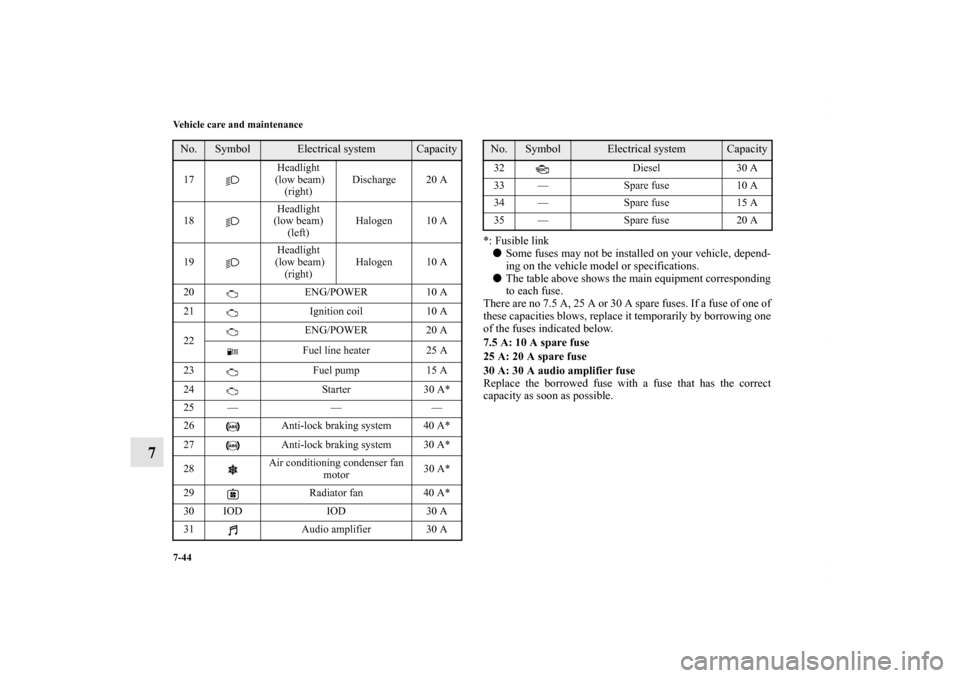
7-44 Vehicle care and maintenance
7
*: Fusible link� Some fuses may not be installed on your vehicle, depend-
ing on the vehicle model or specifications.
� The table above shows the main equipment corresponding
to each fuse.
There are no 7.5 A, 25 A or 30 A spare fuses. If a fuse of one of
these capacities blows, replace it temporarily by borrowing one
of the fuses indicated below.
7.5 A: 10 A spare fuse
25 A: 20 A spare fuse
30 A: 30 A audio amplifier fuse
Replace the borrowed fuse with a fuse that has the correct
capacity as soon as possible.
17 Headlight
(low beam) (right) Discharge 20 A
18 Headlight
(low beam) (left) Halogen 10 A
19 Headlight
(low beam) (right) Halogen 10 A
20 ENG/POWER 10 A
21 Ignition coil 10 A
22 ENG/POWER 20 A
Fuel line heater 25 A
23 Fuel pump 15 A
24 Starter 30 A*
25 — — —
26 Anti-lock braking system 40 A*
27 Anti-lock braking system 30 A*
28 Air conditioning condenser fan
motor 30 A*
29 Radiator fan 40 A*
30 IOD IOD 30 A
31 Audio amplifier 30 ANo.
Symbol
Electrical system
Capacity
32 Diesel30 A
33 — Spare fuse10 A
34 — Spare fuse15 A
35 — Spare fuse20 ANo.
Symbol
Electrical system
Capacity
BK0150700US.book 44 ページ 2012年3月22日 木曜日 午後6時46分
Page 585 of 602
9-2 Specifications
9Vehicle labeling
N01147400654
Keep a record of the chassis number and vehicle identification
number. Such information will assist police if your vehicle is
stolen.1 - Vehicle emission control information labelThe vehicle emission control information label is affixed on the
underside of the engine hood.2 - Vehicle identification number plateThe vehicle identification number is stamped on the plate riv-
eted to the left front corner of the vehicle body. It is visible
from outside of the vehicle through the windshield.3 - Air conditioning labelThe air conditioning label is affixed on the inside panel of the
engine hood.
4 - Vehicle information code plateThe vehicle information code plate is located on the front pas-
senger door sill.
BK0150700US.book 2
ページ 2012年3月22日 木曜日 午後6時46分
Page 592 of 602
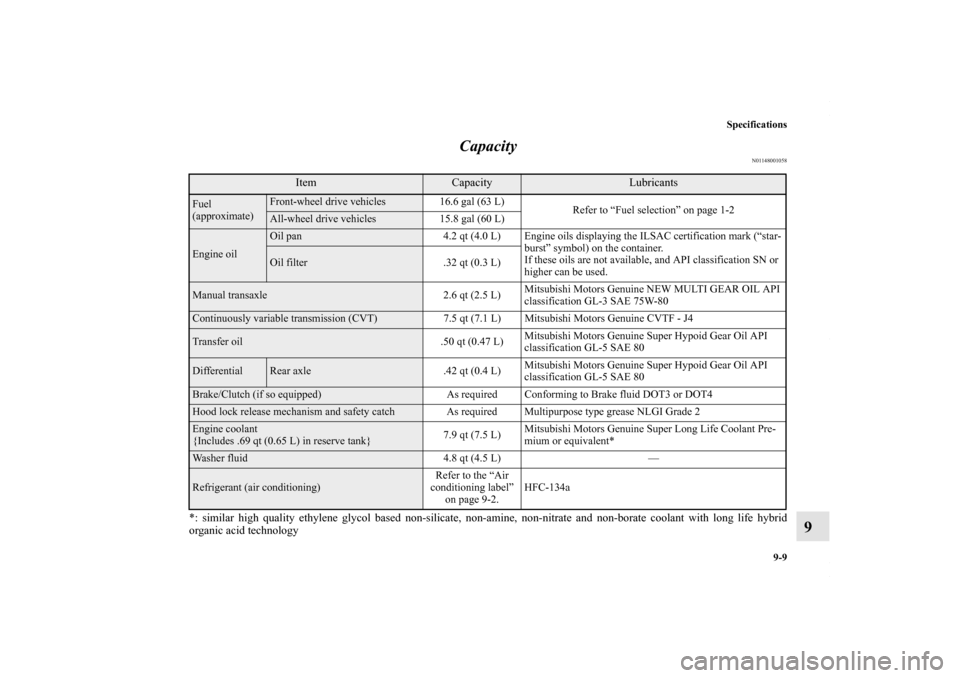
Specifications9-9
9
Capacity
N01148001058
*: similar high quality ethylene glycol based non-silicate, non-amine, non-nitrate and non-borate coolant with long life hybrid
organic acid technology
Item
Capacity
Lubricants
Fuel
(approximate)
Front-wheel drive vehicles 16.6 gal (63 L)
Refer to “Fuel selection” on page 1-2All-wheel drive vehicles15.8 gal (60 L)
Engine oil
Oil pan 4.2 qt (4.0 L) Engine oils displaying the ILSAC certification mark (“star-
burst” symbol) on the container.
If these oils are not available, and API classification SN or
higher can be used.Oil filter .32 qt (0.3 L)
Manual transaxle 2.6 qt (2.5 L)Mitsubishi Motors Genuine NEW MULTI GEAR OIL API
classification GL-3 SAE 75W-80Continuously variable transmission (CVT)
7.5 qt (7.1 L) Mitsubishi Motors Genuine CVTF - J4Transfer oil.50 qt (0.47 L)Mitsubishi Motors Genuine Super Hypoid Gear Oil API
classification GL-5 SAE 80Differential
Rear axle
.42 qt (0.4 L)Mitsubishi Motors Genuine Super Hypoid Gear Oil API
classification GL-5 SAE 80
Brake/Clutch (if so equipped)
As required Conforming to Brake fluid DOT3 or DOT4Hood lock release mechanism and safety catch As required Multipurpose type grease NLGI Grade 2Engine coolant
{Includes .69 qt (0.65 L) in reserve tank}7.9 qt (7.5 L)Mitsubishi Motors Genuine Super Long Life Coolant Pre-
mium or equivalent*Washer fluid
4.8 qt (4.5 L)—Refrigerant (air conditioning) Refer to the “Air
conditioning label” on page 9-2. HFC-134a
BK0150700US.book 9
ページ 2012年3月22日 木曜日 午後6時46分
Page 594 of 602
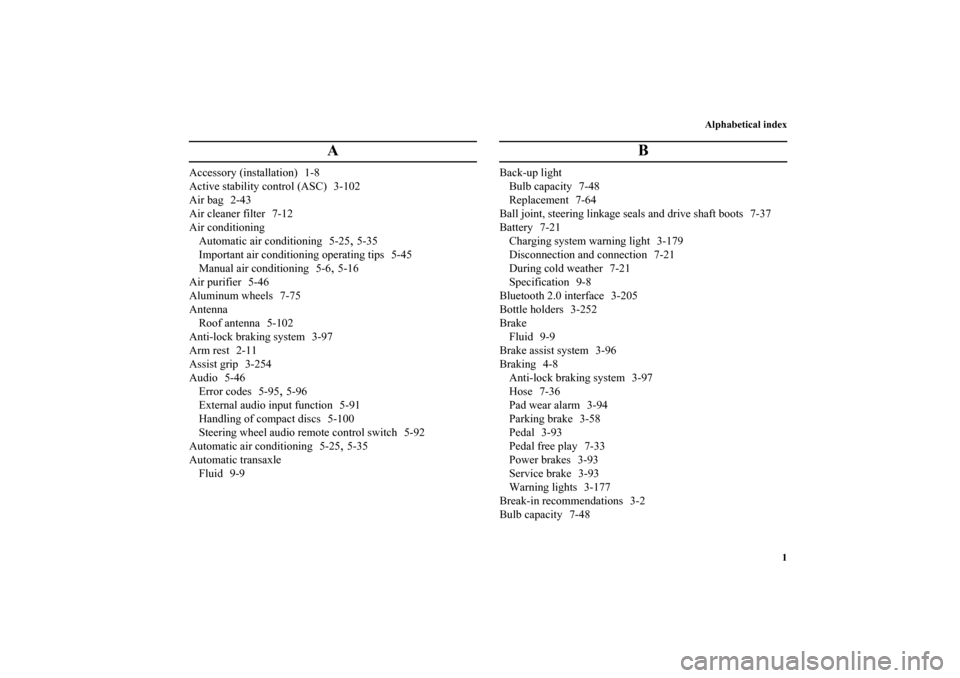
Alphabetical index1
A
Accessory (installation) 1-8
Active stability control (ASC) 3-102
Air bag 2-43
Air cleaner filter 7-12
Air conditioningAutomatic air conditioning 5-25
,5-35
Important air conditioning operating tips 5-45
Manual air conditioning 5-6
,5-16
Air purifier 5-46
Aluminum wheels 7-75
Antenna Roof antenna 5-102
Anti-lock braking system 3-97
Arm rest 2-11
Assist grip 3-254
Audio 5-46 Error codes 5-95
,5-96
External audio input function 5-91
Handling of compact discs 5-100
Steering wheel audio remote control switch 5-92
Automatic air conditioning 5-25
,5-35
Automatic transaxle Fluid 9-9
B
Back-up lightBulb capacity 7-48
Replacement 7-64
Ball joint, steering linkage seals and drive shaft boots 7-37
Battery 7-21 Charging system warning light 3-179
Disconnection and connection 7-21
During cold weather 7-21
Specification 9-8
Bluetooth 2.0 interface 3-205
Bottle holders 3-252
Brake Fluid 9-9
Brake assist system 3-96
Braking 4-8 Anti-lock braking system 3-97
Hose 7-36
Pad wear alarm 3-94
Parking brake 3-58
Pedal 3-93
Pedal free play 7-33
Power brakes 3-93
Service brake 3-93
Warning lights 3-177
Break-in recommendations 3-2
Bulb capacity 7-48
BK0150700US.book 1 ページ 2012年3月22日 木曜日 午後6時46分